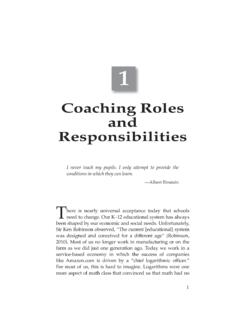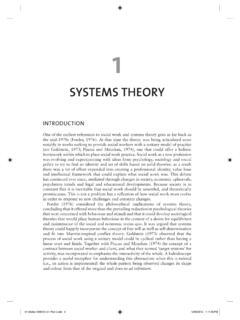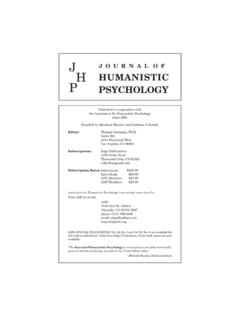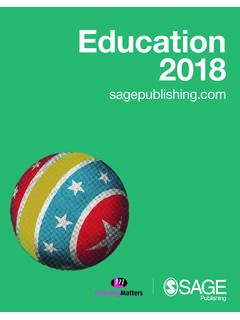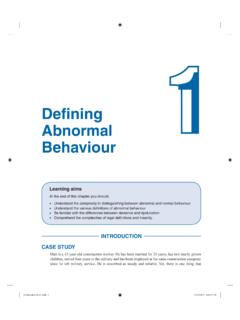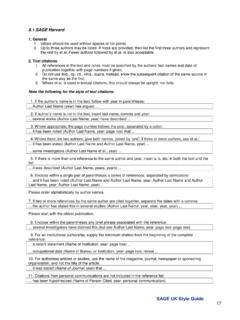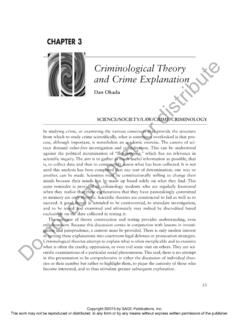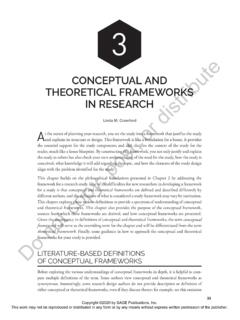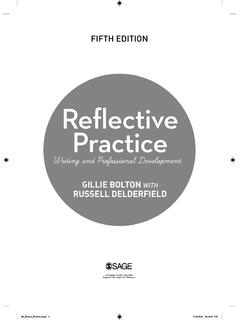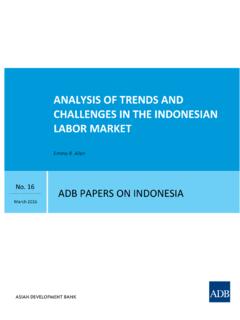Transcription of The Benefits and Challenges of Collaborative Multi-Agency ...
1 22 The Benefits and Challenges of Collaborative Multi-Agency Wor kin gThi s chapter describes: The latest research findings on how sc hool s are implementi ng ECM andengaging collaboratively with other service s an d agencie s The Benefits of Multi-Agency part nership working within edu cationalsettings The ch allenges faced by educatio nal settings in establish in g anddev el oping Multi-Agency partnership working Positive ways forwa rd in meeting the ch al le nges and buildin g themul ti-agency teamThis chap ter is suitable for those who are resear chin g mult i-age ncy work ce nt r esear ch into Every Child Matters and multi-ag ency workingEngag ement in Every Child Matters is nece ssary because the in trinsic links be twe enthe educational setting, services, agencies and the community help to impro ve t heeducat ional achievement.
2 The health an d the soci al choi ces of ch ildren, young p eo -ple an d their fa mi li es . The government continues t o e nco urage schools and o thereducat ional se ttings to collaborate with e ach o th er and wi th outs ide agencies andor gani zations, in ord er to d eliver the five ECM outcomes .One local autho rity s tra teg ic manager commented in a r ecent NFER rep ort o n thevalue of social care pro fessiona ls work ing in extended scho ol s: ECM has been thetool th at peo ple ca n ide ntify with and say, w ell , al though I sit in health or socialcare, o r extended schoo ls, I h ave a part to play .. and it is actually comi ng fromthe Gov ernment (Wilkin et al., 2008: 9).The re h ave bee n a number of research s tud ies and surveys on the implementationof the Every Child Matters agen da in s chools, and how the y are responding to t heneed for grea ter part ne rship working wit h ot he r services and :47 PMPage23 EFFECTIVE Multi-Agency PARTNERSHIPS24 The Nat io na l Fou ndat ion for Educational Res earch i n two annual surveys of trendsin education 2006 and 2007, reported on how th e Ev er y C hil d Matters age nda wasaffe cting sc ho ols.
3 Both surveys identified the fo llo wi ng mai n changes occurr ing asa result of schools en ga ging with Every Chi ld Matters: school improveme nt pla nning reflect ing the five EC M outcomes review of the curriculum and current school p ractice review of staffing and recruitment in school to ali gn EC M with workforceremodelling mark ed g rowth in partn ership involv eme nt and i nform at ion sharing increased extend ed school work imp ro ve d school mea ls and greate r aw are ne ss of heal thy eating and healthylifes tylesThe two NFER surveys on ECM also identi fied the same Challenges facing schools,in delivering the Eve ry Child Ma tters agenda. These were: fin ancial issues, pa rticularly in relati on to sustainabilit y of resources having sufficient time to develop and i mpl ement the ECM agenda de vel oping closer collab oration with other services and agencies involved insupporting children and young pe ople s well NFER surv eys of 2006 and 200 7 bot h found tha t schools had more contact withso me lo cal services t han oth ers.
4 For e xample, 90 per cent of p rimary and secondaryschools surveyed accessed health, social care and th e poli ce mo re than ho usi ngservices which were accessed by only 4 1 per cen t of pri mar y schools and 50 per ce ntof secondary schools. Housing and soci al care w ere the two s er vices which wereconsid er ed to be the least accessib le for s uppo rt b y s chools .The Gene ral Te aching Council publ ish ed a report in autumn 200 7 on EveryChi ld Mat ter s and the Chil dr en s Workforce in schools (GTC, 2007a) . In rela tionto colla bo rat ive wo rki ng b etween schools and multi- agency front-l ine p ractit io nersthe report highlighted th e need for the follow ing: sufficie nt well-trained, high-qual ity front-line practi tioners from services andagenc ies with the capacity to respond effecti vel y to the ECM agenda in order todel ive r preventativ e interventions greater opp ortunit ies for more inter-professional learning, training and devel-opment betwe en school staff and multi -agency practitioners working directlywith pup ils in the sch ool to improve integrated wor ki ng inter-professional tr ainin g in using inter-agency frameworks and pro toco ls, t hatis, Natio na l Servi ce Framework, (NSF), the Common A ssessm ent Framework ,ContactPointCheminais-Ch-02.
5 47 PMPage24 THE Benefits AND Challenges OF Collaborative Multi-Agency WORKING25 the time to inves t i n b uilding quali ty rel atio nship s betw een school staff andmulti-agency front-li ne practitioners clea rer and improved information for schools on whe re to refer children t o andwho to seek spec ific expertise from more up-t o-date information about voluntary s ect or prov ision available more informat ion and a clearer understand ing about the expertis e, role, proc ed uresand processes of children s services and agencies worki ng wi th schools opportunities to get together and work w ith colleagues from other services todevel op an analysis of local needs which can be address ed co llaborativel y greater sharing of exemplification of goo d practi ce i n how to imp lement ECMand Multi-Agency partnersh ip working in ed ucat ional settings mo re s upport for e ducat ional settings in relation to ac countability for monitoringand evaluating the impact of Multi-Agency intervent ions and support on improvingpu pils EC M well-being , A.
6 , et a l. , re por ted onUnderstanding the Reasons why schools do or do not fullyengage with the ECM/ES agenda, on behalf of the NCSL and report findings confirmed those of the NFER and the GTC, i n the nee d fo r: greater clar it y of purpose in connection with other agencies scho ols establishing and consolidating links with partners and other agencies sc hools c rea ting a s hared vision, purpo se, goals wit h ot he r agencies a common und erstanding of t he pro fess ional language us ed ac ros s di fferentmulti-professional disciplines sc hools e st ablishing a clear line of co mmunication, accountability and decisionma king with other ag en cies greater involvement of ou tsid e agenci es o n the s chool s lead ers hip t eam whole-school staff tra in ing on strategi es fo r fo stering Multi-Agency ways ofwo rk ing t oge ther shared evaluative feedback existing between s chools and multi-agencies a clear understanding of the respective ro les and responsibili ti es of p ar tners andagenci es in t he implementation of EC M suffic ient local authority s upport to facilitate and secure Multi-Agency in putsfo r schools, including ring-fenced fun ding to develop and cement such partnership working de signate d staff i n s chools to have the t ime to co-ordi nate the wi de -r angingmulti-agency partnerships for deliver ing E CMCheminais-Ch-02.
7 47 PMPage25 EFFECTIVE Multi-Agency PARTNERSHIPS26 school leaders to focu s more on interrel atio nship buil di ng, col labo rative work-ing , mult i-a gency leadership, in beco ming more political ly astute, in orde r to re- engin eer and transform cultural, profe ssi onal and organisat ional boundar ie sand b en efits of c ollaborative Multi-Agency worki ngThere are many Benefits of mu lti-agency Collaborative partnership w orki ng fo reduc atio nal settings. Ever y Child Matter s is t he gel that holds par tne rship workingtoge ther, and the value it adds contr ibute s immensely to improving the learning andwell-be ing ou tcome s of child ren a nd young peop le .The m ain Benefits of Collaborative Multi-Agency wo rking, e vident in everyday prac-tice within a ra nge of educationa l setti ngs are as fo ll ows.
8 Leads to enhanced and improved o utcomes for children and young pe ople ,through a range of joined-up services, advice and sup port be ing readily availableand easily accessi bl e Benefits teachers understanding of multi -agency practitioners activitie s, andknowing about the services to signpost pupils to , en abling them to focus ontheir core role of teaching helps to build consensus, strengthe n part ne rs hip voice, break down profe ssionalboundar ies and parochia l attitudes helps to enhance scale of coverage and sustain abi li ty when pooled budgets,joint bids, joint projects and en deavours are put i nto act ion can help to build a more cohesive community approach throug h un itedmulti-agency practitioners taking greater ownership and responsibili ty foraddressing local needs j ointly, thus avo iding duplicati on o r overl ap of pr ovis ion promot es mutual support, en couragement and the exchange of ideas betweenstaff, helping the sharing of expertise, kn ow ledge and re source s for traini ng andgood p ract ice, lead in g to more manageable wo rkl oads increased fit between the services o ffere d and those required by childre n, you ngpeople and their families to meet thei r ne eds imp ro ve d c o-ordi nation of services re sulti ng i n be tte r r elations hi ps, imp rovedref errals and the addressin g of joint targets offers a bro ader pe rspective or focus to wor king practice helps to improv e und ersta nding and raise awar eness of issues and agencies.
9 Andother p ro fessionals prac tice increased level of t rus t exis ting b etween part ners/providers in relation to everyoneknowi ng each can a nd wi ll deliverCheminais-Ch-02 :47 PMPage26 facil ita tes joint planning for fu tur e multi -agen cy deve lopments increase d sta ff morale knowing that t he y do not w ork in isolati on and thatissues and problems can be resolved collaboratively more enthusiastic an d committed staff w ho have high expectations of them-selves and exte nde d school co-ordinator in a se con dary s choo l commented: We benefitfrom having the experience of working with peop le from other back gr ounds. Wepick up ot he r perspectiv es an d othe rs w ays o f doi ng things (Coleman, 2006: 14).Th e ch allen ges of Collaborative Multi-Agency workin gThe Challenges that are identified wit h mu lti-age ncy working arise largely as a resultof the complexities involved when pr actitioners engage in collabor ativ e ven fol low ing main c hallen ges a re r eflect ed in r ecent research into multi-agencyworking in schools and children s ce nt re s.
10 Funding concerns in relati on to sustainability, for example, conflic ts over fundingwithin a nd b etween different agencies; a ge neral lack of funding for multi-ag encytraini ng and developmen t work and to cover accommodation a nd on-costs forserv ice delivery. Time only a finite amount of time available to respond to many differentpriorities; some services have waiting lists, for example, CAMHS Communication ensuring clear routes for tw o-way communicatio n be twe enthe e ducat io na l setting, agencies and practitioners in order to exchange infor -ma tion a nd improve join ed -u p co-o rdi nate d work ing. The d anger of a lack of clarity arising about the roles and respons ibil iti es ofpractitioners in a wider and more diverse children s workf orc e. Adapting to working in a n ew and different context, for example, a scho ol o rchi ldren s centre, a s opposed to a ho spital e nvi ronment.
